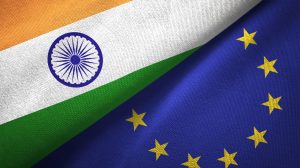This month, the European Union unveiled its new strategy to “reinforce prosperity and security” with India.
The Joint Communication to the European Parliament and the Council proposes structuring the India-EU cooperation agenda around five focus areas: prosperity and sustainability; technology and innovation; security and defense; connectivity and global issues; and enablers across pillars.
Moreover, it dispels any notion that the EU’s “Competiveness Compass” and India’s “Atmanirbhar Bharat” focus are at odds. Instead, the EU Joint Communication on a New Strategic EU-India Agenda commits Europe’s regulatory expertise, single market access, and joint innovation to support India’s inclusive and sustainable growth.
The EU Joint Communication affirming Europe’s intent for deeper engagement with India comes amid ongoing India-EU trade negotiations for a comprehensive Free Trade Agreement (FTA). India’s Minister of Commerce Piyush Goyal recently said that it is important “not to let the search for a perfect deal become the enemy of progress,” adding that the direction of negotiations is “extremely positive.”
This sentiment was echoed by EU Commissioner for Trade and Economic Security (Interinstitutional Relations and Transparency) Maros Sefcovic, who said that India-EU trade negotiations have reached an unprecedented level of “seriousness, mutual trust, and shared ambition.” He even said that efforts are being “maximized to finalize the negotiations by the end of the year.”
This shared emphasis on conducting an FTA stems from the vast untapped potential of India-EU ties. In 2024, India-EU trade in goods reached 120 billion euros, making an increase of about 90 percent over the past decade. This was coupled with services trade rising to 60 billion euros. Around 6,000 European companies operate in India, and EU FDI in India reached 140 billion euros in 2023 – almost doubling over five years. Despite this encouraging trajectory, India accounts for just 2.5 percent of the EU’s total trade.
Hence, even as the two sides navigate the extensive scope of trade negotiations, the EU Joint Communication on India identifies “significant untapped potential” between the “natural strategic partners,” amid global instability caused by “weaponization of dependencies, unilateral trade practices, and widening economic asymmetries.”
This reference to challenges for deeper India-EU cooperation holds special significance amid the global implications of the China-U.S. tech rivalry.
Amid China-U.S. trade tensions, Beijing’s April 2025 decision to require licenses for exports of rare earth alloys, mixtures, and magnets sparked concerns for manufacturing operations across the world. Unlike China’s December 2024 decision on banning exports of gallium, germanium and antimony for the US, the global scope of the April 2025 decision demonstrated Beijing’s willingness to leverage its hold over production and refining of critical minerals.
Moreover, the Trump-Biden-Trump continuity on restricting China’s access to U.S.-made critical tech components raised compliance pressures for third countries. Recently, Malaysia announced permit mandates for export of U.S. AI semiconductors to clamp down against allegations of transshipment of tech components to China. Similarly, Singapore has cracked down against entities reportedly involved in routing of Nvidia’s chips to China’s DeepSeek.
The Trump administration has also continued Biden administration efforts to level the global playing field for American companies complying with U.S. restrictions on China’s access to chip-making equipment and maintenance services. This includes seeking additional compliances from Dutch and Japanese companies, despite Tokyo and Amsterdam aligning export mandates with U.S. regulations shortly after President Donald Trump assumed office in January 2025.
The impact of these widespread pressures of regulatory compliance was also apparent in the EU Joint Communication on India. It underscored that the two sides must “implement robust measures to prevent the unauthorized transfer or misuse of sensitive technologies and knowledge.”
More broadly, the China-U.S. tech rivalry has influenced an adaptive approach across the world. Like-minded nations are seeking long-term tech partnerships and collaborating on supply chain resilience, while also supporting indigenous efforts in tech domains. This trend has also been apparent in Indian and European initiatives.
Given this alignment on adapting to pressures of the China-U.S. tech rivalry, the EU Joint Communication rightly identifies “Technology and Innovation” as a dedicated cooperation track. This includes identifying priority areas under the India-EU Trade and Technology Council (TTC), which was established in 2022 as a consultative ministerial platform to identify convergences at the intersection of trade and tech.
The EU Joint Communication recommends that the India-EU TTC prioritize the EU-India Semiconductor Agreement, cooperation on green technologies, and an early-warning system for Active Pharmaceutical Ingredients (APIs).
Such a directed focus under the India-EU TTC can help foster a collaborative research and development culture between India and Europe, through research partnerships, cross-pollination between start-up ecosystems, and joint skilling and development programs.
India and the EU may also draw on unique strengths, such as India’s successful deployment and expansion of Digital Public Infrastructure (DPI) platforms. Set up under the “Digital India” push, which celebrates its 10th anniversary this year, India’s DPIs have ushered in a revolution of financial inclusion, digital identity-based authentication, and transparent digital governance. The wide adoption of digital platforms has also bolstered India’s start-up ecosystem in the domains of fintech, edtech, and healthtech.
On this aspect as well, the EU Joint Communication makes some pertinent recommendations like setting up “EU-India Innovation Hubs” and “Blue Valleys” as multistakeholder convening platforms for investment facilitation, standards alignment, cross-sectoral collaboration, etc.
Hence, the recently-announced EU strategy on India accords new momentum to priority areas under the India-EU TTC and efforts to develop institutional and talent-mobility bridges between Indian and European tech ecosystems.




























